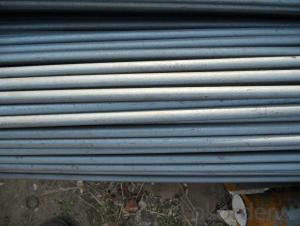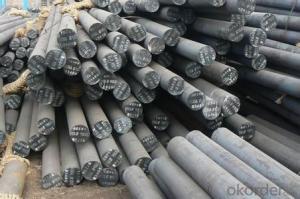hot rolled round bar steel
- Loading Port:
- China Main Port
- Payment Terms:
- TT OR LC
- Min Order Qty:
- -
- Supply Capability:
- -
OKorder Service Pledge
OKorder Financial Service
You Might Also Like
Product Description:
Specifications of Wire Rod Q235:
Steel Grade: Q235, Standard: GB Diameter: 5.5mm, 6.5mm, 7mm,8mm,9mm,10mm,12mm,14mm
Diameter Tolerance:±0.3mm 6.5mm can be drawing into 2mm/8.0mm can be drawing into 3mm
Brand Name: N-RIVER Place of Origin: Hebei, China Mainland Application: construction, building etc
Chemical Composition:
Please kindly find our chemistry of our material based on Q235 as below for your information
Trademark | Rank | Chemical composition (quality score) % | | ||||
C | Si | Mn | S | P | | ||
| | |||||||
| ≤ |
| ≤ | ≤ | | ||
Q235 | A | 0.14-0.22 | 0.30 | 0.30-0.65 | 0.050 | 0.045 | |
Q235 | B | 0.12-0.20 | 0.30 | 0.30-0.70 | 0.045 | 0.045 | |
Trademark | Rank | Pulling Test | | ||||
Bend PointΔs/Mpa | Tensile Strength | Elongation Ratioδ5% | | ||||
| | |||||||
Thickness (Diameter) /MM | Thickness (Diameter) /MM | | |||||
≤16 | 16-40 | | ≤16 | 16-40 | | ||
≥ | | ≥ | | ||||
Q235 | A | 235 | 225 | 375-500 | 26 | 25 | |
Q235 | B | 235 | 225 | 375-500 | 26 | 25 | |
Usage and Applications of Wire Rod Q235:
After hot-rolled the products shaped into coil and delivery as finished product, including round, square, rectangular, hexagonal and so on. Since most of the products are round, it is generally called wire rod. Carbon steel wire rod is widely used in construction and manufacturing. Carbon steel wire rod is mainly used for reinforcement of reinforced concrete and welded structure or reprocessed (roberts , nail, etc.) materials, especially used to produce wire drawing, welding electrode, nails, spring, electronic, precise machinery parts and so on.
Packaging & Delivery of Wire Rod Q235:
Packaging Detail: products are packed in coil and then shipped by container or bulk vessel
Each coil weight: 2-3MT
Delivery Detail: within 45 days after received deposit or LC.
Label: to be specified by customer, generally, each bundle has 1-2 labels
Trade terms: FOB, CFR, CIF
- Q: How do steel round bars differ from other types of steel bars?
- Steel round bars differ from other types of steel bars primarily in their shape. Unlike flat bars or square bars, round bars have a cylindrical shape with a circular cross-section. This shape makes round bars highly versatile and suitable for various applications, such as construction, manufacturing, and engineering. Round bars also offer superior strength and durability due to their uniform composition and absence of sharp edges, making them ideal for load-bearing purposes.
- Q: Are steel round bars suitable for food processing applications?
- Due to its numerous desirable properties, steel round bars are widely utilized in food processing applications. The durability of steel allows it to withstand heavy usage and frequent cleaning in food processing environments, making it an excellent choice for equipment like conveyor belts, mixers, and cutting tools. Moreover, steel round bars exhibit resistance to corrosion, a crucial characteristic for food processing applications that often involve exposure to moisture and various chemicals. This resistance ensures that the equipment remains hygienic and safe for food production. Additionally, steel round bars can be easily machined and fabricated into different shapes and sizes, making them highly versatile for fulfilling various food processing needs. They can be utilized to create custom equipment or components that meet specific requirements, thereby ensuring efficient and effective food processing operations. Furthermore, steel proves to be a cost-effective material for food processing applications. It offers remarkable value for money, delivering long-lasting performance, requiring minimal maintenance, and being readily available in the market. Nevertheless, it is important to note that not all steel round bars are suitable for food processing applications. In this industry, stainless steel is the most commonly used type of steel due to its enhanced corrosion resistance and hygienic properties. Consequently, when selecting steel round bars for food processing applications, it is crucial to ensure that they conform to the necessary standards and regulations for food safety.
- Q: Can steel round bars be used in the production of springs?
- Certainly! Springs can be produced using steel round bars. Steel is a commonly chosen material for manufacturing springs because it possesses strong attributes and excellent durability. Steel round bars are frequently employed as the foundation material for springs because they can be easily manipulated and formed into the desired spring shape. Moreover, by subjecting steel round bars to heat treatment, their mechanical properties can be improved, rendering them appropriate for a range of spring applications. The selection of steel type relies on the desired characteristics and requirements of the spring, such as the desired level of flexibility and resistance to deformation. In summary, steel round bars are extensively employed in spring production due to their outstanding mechanical properties, making them a suitable option for a variety of spring applications.
- Q: Can steel round bars be used for making propeller shafts?
- It is indeed possible to utilize steel round bars in the production of propeller shafts. The utilization of steel in propeller shafts is widespread due to its robustness, endurance, and ability to withstand corrosion. In particular, round bars are frequently favored due to their shape, which offers exceptional strength and load-bearing capabilities. The decision regarding the steel grade and specific properties will be contingent upon the propeller shaft's requirements, such as the desired dimensions in terms of length, diameter, and torque capacity. Moreover, factors like cost, weight, and manufacturability may also play a role in influencing the selection of steel round bars for propeller shafts.
- Q: Can steel round bars be used in the manufacturing of consumer goods?
- Yes, steel round bars can be used in the manufacturing of consumer goods. Steel is a versatile and durable material that can be shaped into various forms, including round bars, to meet specific manufacturing requirements. These round bars can be utilized in the production of a wide range of consumer goods such as furniture, appliances, tools, and automotive components, among others.
- Q: Can steel round bars be used in the manufacturing of home decor?
- Yes, steel round bars can be used in the manufacturing of home decor. They are versatile and can be shaped and welded into various forms, making them suitable for creating furniture, sculptures, and other decorative elements for homes.
- Q: What are the different cutting methods for steel round bars?
- There are several different cutting methods that can be used for steel round bars, depending on the specific requirements and equipment available. Some of the most common cutting methods include: 1. Sawing: This is one of the most basic and traditional methods of cutting steel round bars. It involves using a saw blade with teeth to cut through the metal. Sawing can be done manually with a hacksaw or powered by using a bandsaw or circular saw. It is a versatile method that can be used for both small-scale and large-scale cutting projects. 2. Shearing: Shearing is another common method of cutting steel round bars. It involves using a shear machine or hydraulic press to apply a high amount of force to cut the metal. This method is often used for cutting thick or heavy-duty steel bars. 3. Abrasive cutting: Abrasive cutting involves the use of an abrasive wheel or disc to grind away the metal and create a cut. This method is commonly used for cutting steel round bars with irregular shapes or for precision cutting projects. It can be done manually with a handheld grinder or using a machine like an abrasive cut-off saw. 4. Flame cutting: Flame cutting, also known as oxy-fuel cutting, uses a combination of oxygen and a fuel gas (such as acetylene or propane) to create a high-temperature flame that melts and cuts through the steel. This method is often used for cutting thick steel bars or for shaping metal. 5. Plasma cutting: Plasma cutting is a more advanced method that uses a plasma torch to cut through the steel. The plasma torch generates a high-velocity jet of ionized gas that melts and removes the metal. This method is commonly used for precision cutting, as it allows for greater control and produces cleaner cuts compared to other methods. It is important to note that the choice of cutting method will depend on factors such as the thickness and hardness of the steel round bar, the desired precision of the cut, and the available equipment and resources. It is recommended to consult with a professional or experienced metalworker to determine the most appropriate cutting method for a specific project.
- Q: Can steel round bars be used for making gates?
- Yes, steel round bars can be used for making gates. Steel round bars are strong and durable, making them suitable for gate construction. They can be welded together to create a sturdy gate frame, and can also be used for decorative elements or as pickets. Additionally, steel round bars can be easily customized and shaped to fit the desired gate design.
- Q: Can steel round bars be used for making tools?
- Yes, steel round bars can be used for making tools. Steel round bars are commonly used in tool making due to their strength, durability, and versatility. The high tensile strength of steel makes it suitable for withstanding heavy use and providing stability to tools. Additionally, steel round bars can be easily machined and shaped into various tool designs, allowing for the creation of different types of tools such as wrenches, chisels, punches, and hammers. Moreover, steel's resistance to corrosion ensures that tools made from steel round bars will have a longer lifespan. Overall, steel round bars are a popular choice in tool making due to their excellent mechanical properties and suitability for various applications.
- Q: Can steel round bars be used for making camshafts?
- Yes, steel round bars can be used for making camshafts. Steel is a common material used for camshaft production due to its high strength, durability, and resistance to wear and fatigue. Steel round bars can be machined and shaped into the desired profile, making them suitable for manufacturing camshafts that are critical components in internal combustion engines. The specific type of steel used will depend on the application and performance requirements, but commonly used steels include alloy steels or carbon steels with high mechanical properties. Overall, steel round bars offer a reliable and cost-effective option for producing camshafts that can withstand the demanding conditions of engine operation.
Send your message to us
hot rolled round bar steel
- Loading Port:
- China Main Port
- Payment Terms:
- TT OR LC
- Min Order Qty:
- -
- Supply Capability:
- -
OKorder Service Pledge
OKorder Financial Service
Similar products
Hot products
Hot Searches
Related keywords




























